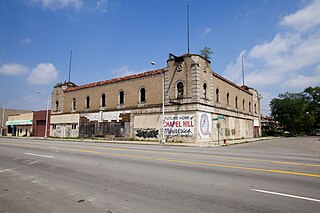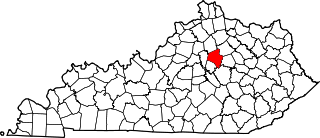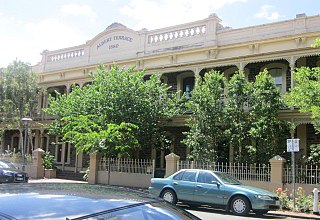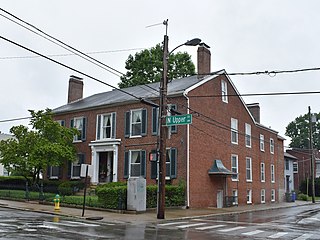
Lexington is a city in Kentucky, United States that is the county seat of Fayette County. By population, it is the second-largest city in Kentucky and 57th-largest city in the United States. By land area, it is the country's 28th-largest city. The city is also known as "Horse Capital of the World". It is within the state's Bluegrass region. Notable locations in the city include the Kentucky Horse Park, The Red Mile and Keeneland race courses, Rupp Arena, Central Bank Center, Transylvania University, the University of Kentucky, and Bluegrass Community and Technical College.

Paris is a home rule-class city in Bourbon County, Kentucky. It lies 18 miles (29 km) northeast of Lexington on the Stoner Fork of the Licking River. Paris is the seat of its county and forms part of the Lexington–Fayette Metropolitan Statistical Area. As of 2020 it has a population of 9,846.

Eminence is a home rule class city in Henry County, Kentucky, in the United States. The population was 2,498 at the 2010 census, up from 2,231 at the 2000 census. Eminence is the largest city in Henry County. Eminence is home to the loudspeaker manufacturing company, Eminence Speaker.

Butchertown is a neighborhood just east of downtown Louisville, Kentucky, United States, bounded by I-65, Main Street, I-71, Beargrass Creek and Mellwood Avenue.

The Surf Ballroom is a Historic Rock and Roll Landmark at 460 North Shore Drive, Clear Lake, Iowa, United States. The Surf is closely associated with the event known colloquially as "The Day the Music Died" – early rock and roll stars Buddy Holly, Ritchie Valens, and J. P. "The Big Bopper" Richardson gave their last performances at the Surf on February 2, 1959, as part of the "Winter Dance Party Tour".
Gideon Shryock was Kentucky's first professional architect in the Greek Revival Style. His name has frequently been misspelled as Gideon Shyrock.

The Hunt–Morgan House, historically known as Hopemont, is a Federal style residence in Lexington, Kentucky built in 1814 by John Wesley Hunt, the first millionaire west of the Alleghenies. The house is included in the Gratz Park Historic District. The Alexander T. Hunt Civil War Museum is located on the second floor of the Hunt–Morgan House.

The Register, originally the South Australian Gazette and Colonial Register, and later South Australian Register, was South Australia's first newspaper. It was first published in London in June 1836, moved to Adelaide in 1837, and folded into The Advertiser almost a century later in February 1931.

The Grande Ballroom is a historic live music venue located at 8952 Grand River Avenue in the Petosky-Otsego neighborhood of Detroit, Michigan. The building was designed by Detroit engineer and architect Charles N. Agree in 1928 and originally served as a multi-purpose building, hosting retail business on the first floor and a large dance hall upstairs. During this period the Grande was renowned for its outstanding hardwood dance floor which took up most of the second floor.

Gratz Park is a neighborhood and historic district located just north of downtown Lexington, Kentucky. It was named after early Lexington businessman Benjamin Gratz whose home stands on the corner of Mill and New streets at the edge of Gratz Park. The Gratz Park Historic District consists of 16 contributing buildings including the Hunt-Morgan House, the Bodley-Bullock House, the original Carnegie Library in Lexington, and several other private residences. Gratz Park occupies a tract of land that was established in 1781 outside the original boundaries of Lexington.

This is a list of the National Register of Historic Places listings in Fayette County, Kentucky.

Carrington Street is a street in the south-eastern sector of the centre of Adelaide, South Australia. It runs east–west, from East Terrace to King William Street, blocked at Hutt Street and crossing Pulteney Street at Hurtle Square. It is one of the narrow streets of the Adelaide grid, at 1 chain wide.

Dicks-Elliott House is a historic home located in Lynchburg, Virginia. It was built in 1813 by Agatha Terrell Dicks, widow of Windsor chair-maker William Dicks. Agatha was the daughter of noted Lynchburg-area Quakers Micajah Terrell and Sarah Lynch. On August 6, 1812, Agatha Dicks' uncle John Lynch sold half-acre Lot Number 175 to Agatha for $1.00.

Lexington House is an historic riverfront hotel located in Catskill Park on the south side of the Schoharie Creek in the Town of Lexington in Greene County, New York. Lexington House was built about 1883 as a middle class resort and is a large, three story frame building arranged in a modified "L" shaped configuration. It features Italianate and Eastlake design elements. Also on the property is the Morse Inn, a former ice house, wagon house and shed. The River Theater stood on the property until about 2011 when it was severely damaged. Its construction coinciding with the development of the Catskill and Tannersville Railway, the Lexington House is a rare surviving example of mid-scale, railroad-era resort architecture. The Lexington House, featuring thirty rooms, advertised facilities for 50-60 guests. Architecturally, the Lexington House embodies a variety of distinctive characteristics commonly associated with this type of resort architecture. On the exterior the most salient features associated with the type are the broad verandah and second-story balconies. Expansive porches and open-air balconies were an essential feature of the resort hotel, providing guests with vistas of the surrounding wilderness and pleasant public spaces for social gatherings. Verandahs also served as sanitary and therapeutic retreats from which to enjoy the healthful and moral atmosphere of nature, reflecting the popularity of resorts not only for pleasure and recreational activity but also for escapes from the crowded, disease-ridden and immoral conditions of the suddenly industrialized cities of the northeast.
The following is a timeline of the history of Lexington, Kentucky, United States.

Providence Chapel is a former Nonconformist place of worship in the village of Charlwood in the English county of Surrey. Founded in 1816 on the outskirts of the ancient village, it was associated with Independent Calvinists and Strict Baptists throughout nearly two centuries of religious use. The "startling" wooden building—remarkably un-English with its simple veranda-fronted style—had seen several years of service as an officers' mess at a nearby barracks. The chapel was put up for sale in 2012. English Heritage has listed it at Grade II* for its architectural and historical importance. It was also on that body's Heritage at Risk Register because of its poor structural condition, but repairs were carried out and in 2019 it was deemed no longer at risk.

The Callas Sweet Shop, at 420 Frederica Ave. in Owensboro, Kentucky was built in Beaux Arts style in 1921. It was listed on the National Register of Historic Places in 1986.

The Abraham Barton House in Lexington, Kentucky, is a 2+1⁄2-story Greek Revival structure dating from 1795. The house was constructed in multiple stages, and the original dwelling faced Second Street. Architect Gideon Shryock is credited both for the Greek Revival expansion and remodel in the early 1830s and for changing the front exposure to face North Upper Street. The House was added to the National Register of Historic Places in 1977.

The Lexington Herald Building, also known as the Nunn Building, in Lexington, Kentucky, is a 4-story commercial structure designed by Leon K. Frankel of Frankel & Curtis and constructed in 1917 as headquarters of the Lexington Herald. F. Paul Anderson, dean of the College of Engineering at University of Kentucky, where Frankel was also a professor, consulted on the steel frame of the brick building. The building's ornamentation is minimal, and it includes a denticulated cornice above the fourth floor windows and a parapet. There is a gable in the parapet in the front center holds a decorative scroll displaying an "H". The building was added to the National Register of Historic Places in 1982.

The Higgins Block, also known as the Fayette Cigar Store, in Lexington, Kentucky, is a 3-story brick building designed by John McMurtry and constructed in 1872. The cast iron, Italianate facade originally contained five storefronts on West Main Street, each with three window bays. The surviving 2-storefront building is a remnant of the original commercial block, shortened in 1912 when construction of the Fayette National Bank Building required demolition of part of the Higgins Block. The remains of the Higgins Block were added to the National Register of Historic Places in 1977.




















